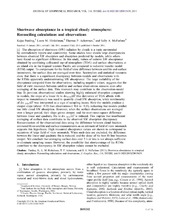| dc.contributor.author | Parding, Kajsa | eng |
| dc.contributor.author | Hinkelman, Laura M. | eng |
| dc.contributor.author | Ackerman, Thomas P. | eng |
| dc.contributor.author | McFarlane, Sally A. | eng |
| dc.date.accessioned | 2014-12-18T08:54:16Z | |
| dc.date.available | 2014-12-18T08:54:16Z | |
| dc.date.issued | 2011-10-04 | eng |
| dc.identifier.issn | 0148-0227 | en_US |
| dc.identifier.uri | https://hdl.handle.net/1956/8973 | |
| dc.description.abstract | [1] The absorption of shortwave (SW) radiation by clouds is a topic surrounded by contradictory reports and controversy. Some studies have shown large discrepancies between observed SW absorption and absorption predicted by models, while others have found no significant difference. In this study, values of column SW absorptance obtained by combining collocated top-of-atmosphere (TOA) and surface observations at an island site in the tropical western Pacific are compared to radiative transfer model (RTM) output. To compensate for the field of view difference between satellite and surface instruments, the surface data are averaged over time. Scatterplots and statistical measures show that there is a significant discrepancy between models and observations with the RTMs apparently underestimating SW absorptance. The large variability of the absorptance computed from the observations, including negative values, suggests that the field of view mismatch between satellite and surface observations remains even after averaging of the surface data. This mismatch may contribute to the observation-model bias. In previous observational studies showing highly enhanced absorption compared to models, the slope of a linear fit to dαTOA/dT (the derivative of TOA albedo with respect to transmittance) was used to quantify cloud SW absorption, while nonlinearity of dα TOA/dT was interpreted as a sign of sampling issues. Here the models produce a steeper slope (about −0.9) than observations (−0.6 to −0.8), indicating that models predict too little cloud SW absorption. However, when the surface observations are averaged over a longer period, their slope grows steeper, and the root-mean-square difference between linear and quadratic fits to dα TOA/dT is reduced. This implies that insufficient averaging of surface data contributes to the observed SW absorption discrepancy. Reexamination of the observational data using the difference between cloud fraction estimated from satellite and surface measurements as an estimate of field of view mismatch supports this hypothesis. High measured absorptance values are shown to correspond to occasions of large field of view mismatch. When such data are excluded, the difference between the linear and quadratic fits is reduced, and the slope of the best fit line becomes steeper. We conclude that averaging surface data over 3 h or less is not always sufficient to eliminate sampling issues. However, the possibility that shortcomings of the RTMs contribute to the discrepancy in SW absorption values cannot be excluded. | en_US |
| dc.language.iso | eng | eng |
| dc.publisher | Wiley | en_US |
| dc.publisher | American Geophysical Union | en_US |
| dc.relation.ispartof | <a href="http://hdl.handle.net/1956/8974" target="_blank">Decadal solar irradiance variability in northern Europe</a> | en_US |
| dc.subject | anomalous cloud absorption | eng |
| dc.subject | shortwave radiation | eng |
| dc.title | Shortwave absorptance in a tropical cloudy atmosphere: Reconciling calculations and observations | en_US |
| dc.type | Peer reviewed | |
| dc.type | Journal article | |
| dc.description.version | publishedVersion | en_US |
| dc.rights.holder | Copyright 2011 American Geophysical Union | en_US |
| dc.source.articlenumber | D19202 | |
| dc.identifier.doi | https://doi.org/10.1029/2011jd015639 | |
| dc.identifier.cristin | 883495 | |
| dc.source.journal | Journal of Geophysical Research - Atmospheres | |
| dc.source.40 | 116 | |
| dc.source.14 | 16 | |
